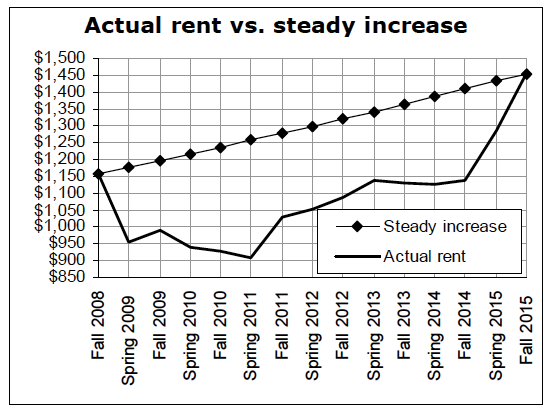Dupre + Scott: Why Rent Increases Feel Like a Ride on a Skyrocket
I can’t resist another post based on the latest Apartment Advisor Newsletter from Dupre + Scott. One of the great services Dupre + Scott has done over the last few years of the housing discussion in Seattle is to temper the heated rhetoric about “skyrocketing” rents by trying to inject some data and facts into the discussion. In one example from the newsletter, Dupre + Scott looks at one building’s rents over the last 7 years. What happens is interesting and instructive about why the anecdotal evidence is so striking. In this building rents rose over 6 years by over $300, and most of that came in the last year, an increase of about 28 percent. That definitely feels like a skyrocket.
The actual increase over the time period does look pretty steep. But you can see that the rents went down and then started a slow rise back up until most of the ground lost since 2008 was made up.
Yes, a 28% increase hurts. Especially when it happens in one year. After all, it was a $316 a month increase. That will strain anyone’s budget if they weren’t prepared for it. But that’s the only side of the story we hear about in the media. Once again, take a step back and look at the bigger picture. Even after the large increase in the past year, rents increased just 3.3% a year over the past seven years. Well that’s just too boring for a headline, isn’t it?
So even though in the big picture rents didn’t “skyrocket” most of the increase came all at once. But one thing to remember is that over the whole span, renters experienced some serious savings on costs, real money they could use for other things for that time period. How much did renters save in this building?
They each enjoyed $19,205 of lower rents over the past seven years compared to paying a 3.3% increases each year. That’s a $19,205 windfall for each resident, even after a 28% rent increase in the past year. That $19,205 savings will cover the $316 a month rent increase for the next five years.
I’m sure that a person living in this building the whole time wouldn’t be all that consoled by seeing that they saved almost $20,000 since the rent started going down. But maybe their income increased along with the recovery in the economy. Maybe it didn’t. Maybe the person got married or divorced and experienced an over all change in household income. Maybe the person absorbed the increase with no trouble. Maybe the increase forced them to find another place to live. All these factors contribute to how the rent increase feels and how it is perceived by policy makers.
The example shows that while broadly we don’t have a crisis, a 28 percent increase in one year makes a great story for the media that validates that the perception that we do have one. Until we get smarter about how we consider what’s happening in the market and individuals in that market, the housing discussion is going to continue to be like trying to read a book with a microscope. We need to find a better measure of when a person needs help (like the residual income model) and better measures of the whole market. Until we put work into that, we’re going to keep getting skyrocketing rhetoric rather than solutions to real people’s problems.



